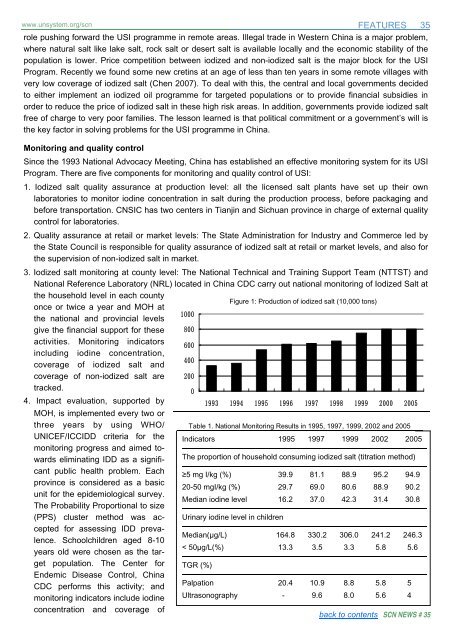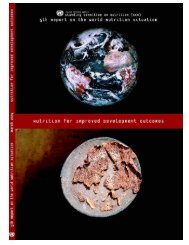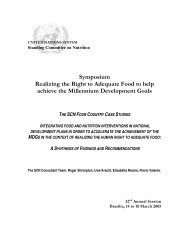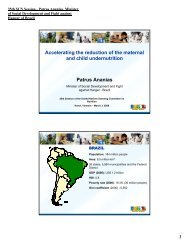Universal Salt Iodization (USI) - FTP Directory Listing
Universal Salt Iodization (USI) - FTP Directory Listing
Universal Salt Iodization (USI) - FTP Directory Listing
- No tags were found...
You also want an ePaper? Increase the reach of your titles
YUMPU automatically turns print PDFs into web optimized ePapers that Google loves.
www.unsystem.org/scn FEATURES 35role pushing forward the <strong>USI</strong> programme in remote areas. Illegal trade in Western China is a major problem,where natural salt like lake salt, rock salt or desert salt is available locally and the economic stability of thepopulation is lower. Price competition between iodized and non-iodized salt is the major block for the <strong>USI</strong>Program. Recently we found some new cretins at an age of less than ten years in some remote villages withvery low coverage of iodized salt (Chen 2007). To deal with this, the central and local governments decidedto either implement an iodized oil programme for targeted populations or to provide financial subsidies inorder to reduce the price of iodized salt in these high risk areas. In addition, governments provide iodized saltfree of charge to very poor families. The lesson learned is that political commitment or a government’s will isthe key factor in solving problems for the <strong>USI</strong> programme in China.Monitoring and quality controlSince the 1993 National Advocacy Meeting, China has established an effective monitoring system for its <strong>USI</strong>Program. There are five components for monitoring and quality control of <strong>USI</strong>:1. Iodized salt quality assurance at production level: all the licensed salt plants have set up their ownlaboratories to monitor iodine concentration in salt during the production process, before packaging andbefore transportation. CNSIC has two centers in Tianjin and Sichuan province in charge of external qualitycontrol for laboratories.2. Quality assurance at retail or market levels: The State Administration for Industry and Commerce led bythe State Council is responsible for quality assurance of iodized salt at retail or market levels, and also forthe supervision of non-iodized salt in market.3. Iodized salt monitoring at county level: The National Technical and Training Support Team (NTTST) andNational Reference Laboratory (NRL) located in China CDC carry out national monitoring of Iodized <strong>Salt</strong> atthe household level in each countyFigure 1: Production of iodized salt (10,000 tons)once or twice a year and MOH at1000the national and provincial levelsgive the financial support for these 800activities. Monitoring indicators600including iodine concentration,400coverage of iodized salt andcoverage of non-iodized salt are 200tracked.04. Impact evaluation, supported by1993 1994 1995 1996 1997 1998 1999 2000 2005MOH, is implemented every two orthree years by using WHO/ Table 1. National Monitoring Results in 1995, 1997, 1999, 2002 and 2005UNICEF/ICCIDD criteria for the Indicators 1995 1997 1999 2002 2005monitoring progress and aimed towardseliminating IDD as a significantThe proportion of household consuming iodized salt (titration method)public health problem. Each≥5 mg I/kg (%) 39.9 81.1 88.9 95.2 94.9province is considered as a basic20-50 mgI/kg (%) 29.7 69.0 80.6 88.9 90.2unit for the epidemiological survey.Median iodine level 16.2 37.0 42.3 31.4 30.8The Probability Proportional to size(PPS) cluster method was acceptedUrinary iodine level in childrenfor assessing IDD preva-Median(μg/L) 164.8 330.2 306.0 241.2 246.3lence. Schoolchildren aged 8-10< 50μg/L(%) 13.3 3.5 3.3 5.8 5.6years old were chosen as the targetpopulation. The Center for TGR (%)Endemic Disease Control, ChinaCDC performs this activity; andPalpation 20.4 10.9 8.8 5.8 5monitoring indicators include iodine Ultrasonography - 9.6 8.0 5.6 4concentration and coverage ofback to contents SCN NEWS # 35







